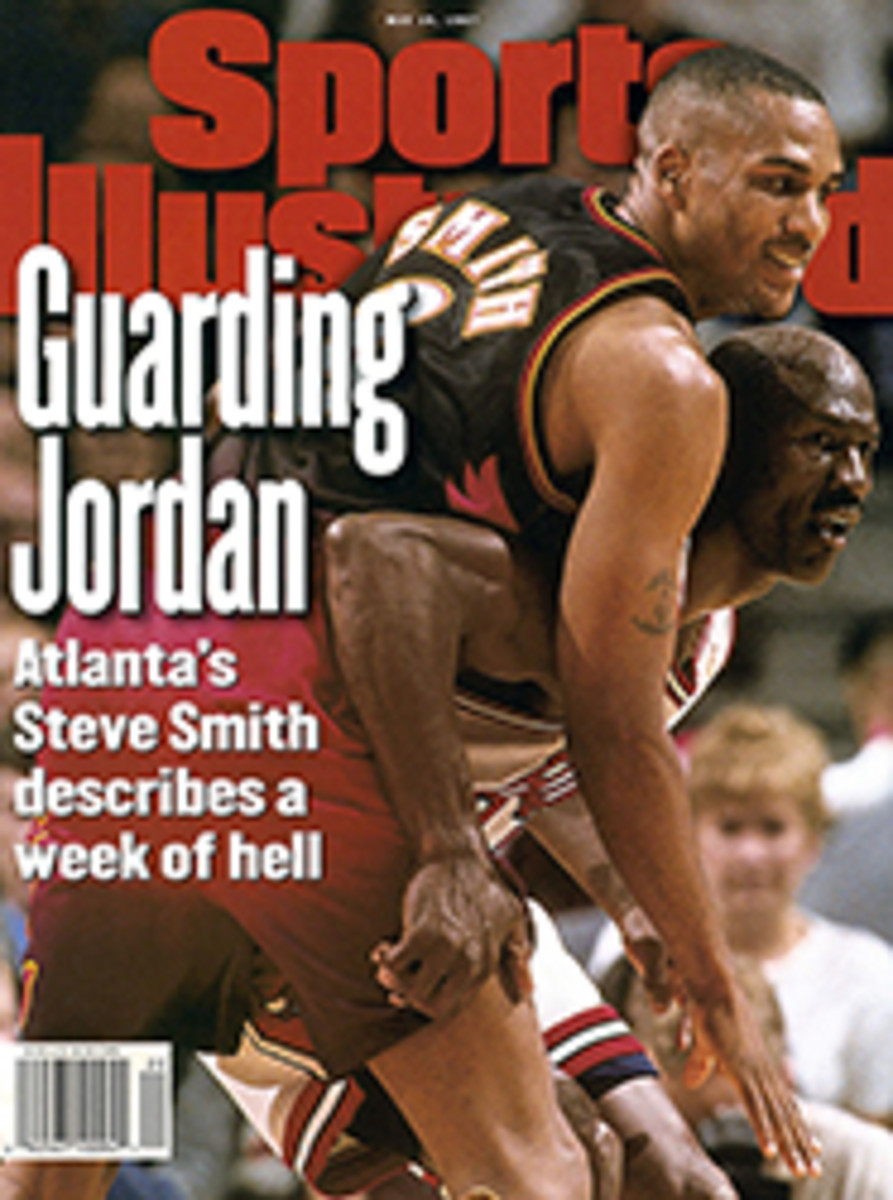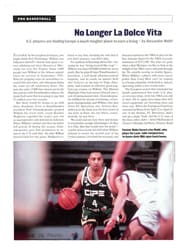
THIS GUY COULD TAKE A PUNCH AS MIDDLEWEIGHT CHAMP, GENE FULLMER WAS A BRAWLER WITH A KEEN SENSE OF HUMOR
The chin that caught the most famous left hook in boxing history
anchors a crushed, pulpy face. Repeated pummeling by the best
middleweights of the 1950s has left the face eerily geometric.
The lips are stretched half ovals; the ears are flattened
semicircles; the nose is a squashed isosceles triangle. "This
nose runs in the family," Gene Fullmer says. "Boxing didn't help
it any."
At 65, Fullmer is a little more thickly constructed than he was
in January 1957, when he upset Sugar Ray Robinson for the
160-pound world title at Madison Square Garden in New York City.
Fullmer, a mauling, brawling apprentice welder, fought Robinson
four times and lost only once. But that defeat is as indelible
as the blood that still stains the trunks Fullmer wore. Forty
years ago this month, he waded into Robinson's sublimely timed
left hook, pitched to the canvas and surrendered the crown he
had won 119 days before. Fullmer doesn't remember the punch. "I
never even saw it," he says. All he recalls is gazing up from
the floor and seeing Robinson bounce up and down.
"How come Sugar Ray's doing exercises between rounds?" Fullmer
asked his manager, Marv Jenson.
"It's not between rounds," said Jenson. "The ref counted to 10."
"Jeez! It must have been me who got counted out, 'cause I didn't
hear any of it."
Fullmer laughs at the memory. He laughs easily and often--a
rough, giddy, slightly dippy laugh that sounds like cheese
graters mating. He's laughing right now while he rummages in the
trophy room of the house he had built on his grandfather's
homestead in West Jordan, Utah. "No, I don't have Alzheimer's,"
he says, "I have Halfheimer's. I don't remember half of what I
ought to." He half-remembers where he put his old boxing trunks
and gloves. "Here's the eight-ounce gloves I wore for the first
Robinson fight," he says. "And here's the six-ouncers I wore for
the second. It's the only time I ever wore gloves that light,
and it may have cost me the title."
In a black-and-gold-flecked plaster case are the gloves that
knocked out Carmen Basilio in 1959 for the vacant National
Boxing Association's middleweight title. "They always had a good
feel," Fullmer says. "Like I could put them right through a wall
if I had to." The gloves his late wife, Dolores, put on a wall
dangle inside a trophy case. Dolores nailed them there after
they failed to ward off Fullmer's final opponent, Dick Tiger, in
1963. "I hung your gloves up," Dolores told Gene after the
seventh-round TKO, "and that's where they're staying." They
haven't budged in 34 years.
"Cyclone" Gene Fullmer walloped his way to the middleweight
championship of the world, lost it, regained it and defended it
seven times. He won 55 fights, lost six and drew three. "I had a
terrific time taking some terrible beatings," he says, massaging
the bulging flesh above his brows. "Now I just raise a few pigs
and a few horses. And I lose money on all of them."
He used to raise minks, but he gave that up after marrying his
second wife, Karen. "In 14 years Karen and I have never had an
argument," Fullmer says. "We've followed two rules since our
wedding day. Rule 1 is that I wouldn't leave her on account of
her kids, and she wouldn't leave me on account of my mother.
Rule 2 is that her money is her money, and my money is her
money. So what's there to fight about?"
Fullmer pushes his nose with his thumb, bending it like putty.
The nose has been changing shape since the day he raced down a
sidewalk, tripped over a tire and splatted face first on the
concrete. "I was three," he says. "That's what happens when
you're named after a fighter."
The fighter was Gene Tunney, the handsome heavyweight champ of
the 1920s. Family lore has it that Tuff Fullmer took one look at
his newborn son and said, "Maybe we ought not name him after
Tunney."
"Why not?" asked Mary Fullmer, the boy's mother.
"He ain't so good-lookin'."
"Well, he ain't gonna hurt his looks none fightin'." Gene it was.
After teaching his son everything he had learned from a brief
and unmemorable career in the ring, Tuff turned the 12-year-old
Gene over to Jenson, a local mink rancher who bred fighters in
his basement gym. Jenson nurtured Gene's greatest talent:
stamina. When he was 18, Fullmer was working full time in
Kennecott Copper's huge open-pit mine in Bingham, Utah, but he
still had enough energy to run four miles every morning and
train with Jenson for two hours after his shift was over.
To improve Fullmer's flexibility, Jenson had him club a heavy
bag with a Louisville Slugger, Willie Mays model. To flummox the
opposition, Jenson had him throw punches by numbered signals
called from the corner.
Fullmer had been working with Jenson for more than a decade when
he got his shot at Robinson. He was 25 and had won 37 of 40
bouts, 20 by knockout. To face the 35-year-old champ, the
challenger had to settle for the skimpiest of terms. Robinson
pocketed 42.5% of the Madison Square Garden gate, plus $60,000
from the TV rights. Fullmer's take was 12.5% of the gate. "Sugar
Ray always wanted all of the money," says Fullmer. "And he
nearly got it."
Robinson made prizefighting seem like a ballet of feet and fists
in magical coordination. Fullmer was the classic pug: slow and
squat, with sloping shoulders. Known for his clumsy rushes and
reckless punches, he led with his skull and caught as much as he
threw. "My philosophy was to move forward and swing," Fullmer
says. "I'd get on a guy like stink."
He stunk up Robinson from the opening bell. Crowding in and
hanging his face out to be slugged, Fullmer threw fists and
shoulders with fierce abandon. He and Robinson sprawled around
the ring in grotesque clinches. In the seventh round Fullmer
even pushed the aging champ through the ropes. At the end of the
15th Fullmer was awarded a unanimous decision. Back in West
Jordan he was feted with parties and parades. For a few weeks
the town even changed its name to Fullmerville. Meanwhile,
Fullmer went back to work in the mine for $17.56 a day.
The rematch was set for May 1, in Chicago Stadium. Four rounds
into the fight, Fullmer led on all cards. But one of Robinson's
handlers had noticed Fullmer's habit of sticking his left out
like a fender and then lunging forward with a swinging right.
Early in Round 5, Robinson exploited that habit by landing a
couple of righthand leads to the body that dropped Fullmer's
guard. As Fullmer readied a roundhouse, Robinson reached back
across the years for one of those punches that end a fight in a
moment. A moment later the old champ was the new champ. "It was
the best left hook I've ever seen," says Jenson, who still lives
in West Jordan, "and also the worst." Ring magazine recently
named it the greatest knockout punch in the history of boxing.
Although Fullmer was still ranked No. 1 in the middleweight
class after the loss, it was two years before he got his next
title shot. He regained the crown with a TKO over Basilio. Two
of Fullmer's seven successful defenses were against Robinson.
The first ended in a draw; the second, a 15-round decision. But
neither proved tougher than Fullmer's 15-round split decision
victory over Florentino Fernandez. Fullmer fought the last two
rounds with a broken right hand. "Did I ever consider quitting?"
he repeats incredulously. "The thought never crossed my mind."
It did at his final bout, with Tiger, for the vacant world
title. Blinded by a cut at the edge of his right eye, Fullmer
raged around the ring like an injured bull in a corrida.
Finally, after Round 7, Jenson threw in the towel.
"I would have liked to have fought once more," Fullmer says,
"just to see if I was that bad." A smile creases his broken
boxer's face. "But I really didn't want anyone else to know if I
was."
COLOR PHOTO: KENT MILES Jenson (right) began training Fullmer in his basement gym 53 years ago, when Gene was 12. [Gene Fullmer and Marv Jenson]
B/W PHOTO: UPI/CORBIS BETTMANNFullmer led the second fight until Robinson threw the textbook left that knocked him out. [Sugar Ray Robinson and Gene Fullmer boxing]

